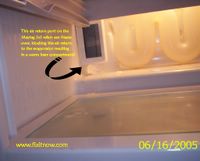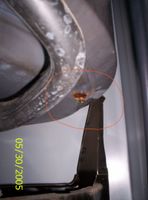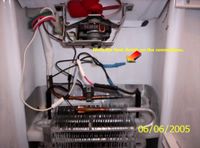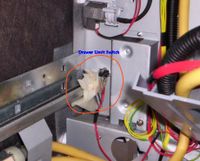Had an interesting one the other day. This was the newer Maytag MAV top-loading washer. Complaint was that the washer wouldn’t run; it just made a horrible buzzing noise when you pulled the timer knob to start it. What’s worse, the tub was full of rancid washer water.
I verified the complaint and placed the source of the noise as coming from inside the cabinet, not the control panel. This is an all-important first step because, in accordance with Samurai’s 6th Law of Appliance Repair, “Begin troubleshooting directly at the problem,” it tells me that I should begin by checking the mechanical drive system of the machine. So I began this excursion into appliance repair excellence by removing the front panel of the washer.
Using a flashlight, I located the clips in the top seam of the front panel. Then I used my putty knife to push in the clips and pop the hood. With the hood raised, I located and removed the two 5/16″ black hex screws on the inside holding the front panel to the rest of the cabinet using my magnetic hex driver. The front panel tilted out, up, and off. Once the front panel was removed, I had access to all the mechanical guts.
I pulled the timer knob again and the buzzing noise was definitely coming from the motor. To eliminate the possibility that the motor was having blocked rotor effect from a seized transmission, I pulled off the drive belt and ran it again. Same noise. So the problem was definitely related to the motor or its power circuitry.
Next step was to open the control console and get the schematic diagram for the washer so I could do some basic electrical tests. I removed the motor’s wiring harness and tested the motor’s start and run windings for continuity. Both checked good.
Ok, it was time to take it to the next level.
The next weapon in my arsenal of troubleshooting tricks is the live electrical test. This is where I measure voltage in a live circuit. Please, I AM a professional so don’t try this at home. My objective here was to see if the motor was getting the right voltage, meaning 120vac (nominal), to the right places. With the harness still disconnected, I used the schematic diagram for the washer to locate the pins on the wiring harness corresponding to the motor’s start and run windings. Once located, I pulled the timer knob to energize the circuit and measured the voltage at the pins using my multimeter. Voltage to the run winding was good but the start winding voltage was AWOL. Things were getting curiouser and curiouser.
Now here’s where the parts changing monkeys get separated from the Master Appliantologists. At this stage, monkey boy would think the timer was bad and order a new one. But, alas, he would choke and gag on the bitter herb of disappointment. For the problem, in this case, was not the timer; nay, nay, young Grasshopper, behold:
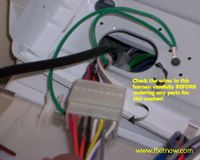
Wiring harness on the Maytag MAV top-load washers. If the motor won’t run and the washer makes a buzzing noise when you start it, check this harness before you replace any parts!
I pulled the harness apart and noticed a teentsy-weentsie black spot on the end of the male spade on the white wire. “Hmmm,” I said, whilst scratching myself in my most ponderous fashion, “what’s this?” I removed my bifocals and stuck my face up close and personal to that harness and, yea verily, that black spot was revealed to be a tiny electrical arc. Being a certifiable appliance guru, I knowed that electrical arcs occur because of loose connections. So I looked at the female side of the harness assembly and saw that the number nine white wire was pulled out of the harness by the barest fraction of an inch. Here’s a detailed diagram of the harness:

Wiring harness connector in the console of the newer Maytag MAV washers. If the motor won’t run, check the 9 White wire in this harness.
I re-seated the white wire and re-connected the wire harnesses at the console and motor. Now it was time for the moment of truth. I pulled the timer knob and… that bad boy fired right up! I let the washer pump out all that putrid water, received glowing accolades (in the form of a check) from my grateful customer and went skipping and plucking on my merry way to the beer store. And drank heavily ever after. The End.

